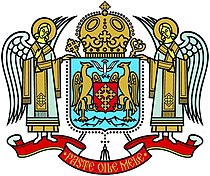
Back Roemeens-Ortodokse Kerk Afrikaans الكنيسة الرومانية الأرثوذكسية Arabic الكنيسة الرومانيه الارثوذكسيه ARZ Rumın Pravoslav Kilsəsi Azerbaijani Румынская праваслаўная царква Byelorussian Румынская праваслаўная царква BE-X-OLD Румънска православна църква Bulgarian Església Ortodoxa Romanesa Catalan Rumunská pravoslavná církev Czech Den rumænsk-ortodokse kirke Danish
| Romanian Orthodox Church | |
|---|---|
| Biserica Ortodoxă Română | |
 Coat of arms | |
| Abbreviation | ROC (in English) BOR (in Romanian) |
| Type | Eastern Christianity |
| Classification | Eastern Orthodox |
| Scripture | Septuagint, New Testament |
| Theology | Eastern Orthodox theology |
| Polity | Episcopal |
| Primate | Daniel, Patriarch of All Romania |
| Bishops | 58 |
| Priests | 15,068[1] |
| Distinct fellowships | Ukrainian Orthodox Vicariate, Army of the Lord |
| Parishes | 15,717[1] |
| Monastics | 2,810 men, and 4,795 women[1] |
| Monasteries | 359[1] |
| Associations | Eastern Orthodox Church |
| Language | Romanian |
| Liturgy | Byzantine Rite |
| Headquarters | Dealul Mitropoliei, Bucharest |
| Territory | Romania Moldova |
| Possessions | Serbia Hungary Western and Southern Europe; Germany, Central and Northern Europe; Americas; Australia and New Zealand |
| Founder | (as Metropolis of Wallachia) Iachint of Vicina, Nicholas Alexander Miron Cristea, Ferdinand I |
| Independence | 1865 |
| Recognition | 25 April 1885 (Autocephalous metropolis) 1925 (Autocephalous Patriarchate) |
| Absorbed | Romanian Greek Catholic Church (1948) |
| Separations | Old Calendarist Romanian Orthodox Church (1925) Evangelical Church of Romania (1927) Romanian Greek Catholic Church (1990) |
| Members | 16,367,267 in Romania;[2] 720,000 in Moldova[3] 11,203 in United States[4] |
| Publications | Ziarul Lumina |
| Official website | patriarhia.ro |
| Part of a series on the |
| Eastern Orthodox Church |
|---|
| Overview |
The Romanian Orthodox Church (ROC; Romanian: Biserica Ortodoxă Română, BOR), or Romanian Patriarchate, is an autocephalous Eastern Orthodox church in full communion with other Eastern Orthodox Christian churches, and one of the nine patriarchates in the Eastern Orthodox Church. Since 1925, the church's Primate has borne the title of Patriarch. Its jurisdiction covers the territories of Romania and Moldova, with additional dioceses for Romanians living in nearby Ukraine, Serbia and Hungary, as well as for diaspora communities in Central and Western Europe, North America and Oceania. It is the only autocephalous church within Eastern Orthodoxy to have a Romance language for liturgical use.
The majority of Romania's population (16,367,267, or 85.9% of those for whom data were available, according to the 2011 census data[5]), as well as some 720,000 Moldovans,[3] belong to the Romanian Orthodox Church.
Members of the Romanian Orthodox Church sometimes refer to Orthodox Christian doctrine as Dreapta credință ("right/correct belief" or "true faith"; compare to Greek ὀρθὴ δόξα, "straight/correct belief").[citation needed]